
New Zealand dinosaurs
Encyclopedia
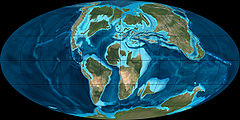
Dinosaur
Dinosaurs are a diverse group of animals of the clade and superorder Dinosauria. They were the dominant terrestrial vertebrates for over 160 million years, from the late Triassic period until the end of the Cretaceous , when the Cretaceous–Paleogene extinction event led to the extinction of...
s in New Zealand
New Zealand
New Zealand is an island country in the south-western Pacific Ocean comprising two main landmasses and numerous smaller islands. The country is situated some east of Australia across the Tasman Sea, and roughly south of the Pacific island nations of New Caledonia, Fiji, and Tonga...
. Possibly because it lacks the right conditions for fossilisation, only fragments of bone and a few vertebrae have been found there.
Because these fossils are only a single bone or a piece of a bone, the dinosaurs' species cannot be identified, but by comparing the fossils with others it can be seen which family
Family (biology)
In biological classification, family is* a taxonomic rank. Other well-known ranks are life, domain, kingdom, phylum, class, order, genus, and species, with family fitting between order and genus. As for the other well-known ranks, there is the option of an immediately lower rank, indicated by the...
or order
Order (biology)
In scientific classification used in biology, the order is# a taxonomic rank used in the classification of organisms. Other well-known ranks are life, domain, kingdom, phylum, class, family, genus, and species, with order fitting in between class and family...
a given fossil belonged to.
Marine fossils are more common than fossils of land animals in New Zealand because dead animals and plants are easily preserved in sand and mud. Therefore, some fossils of large marine reptiles are nearly complete, and so can be identified to species.
Species
So far, there have been fossils found in New Zealand that have been identified as coming from: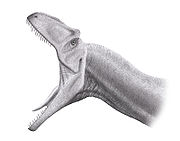
Non-Avian
| Name | Period | Diet | Notes |
|---|---|---|---|
| Ankylosaur | Cretaceous Cretaceous The Cretaceous , derived from the Latin "creta" , usually abbreviated K for its German translation Kreide , is a geologic period and system from circa to million years ago. In the geologic timescale, the Cretaceous follows the Jurassic period and is followed by the Paleogene period of the... |
Herbivore | Probably a Nodosaur similar to Minmi Minmi is a Japanese hip-hop, soca, and reggae musician, as well as a singer-songwriter and record producer. She is the first soca artist from Japan. Since 2007, she has been married to , a member of Japanese reggae group Shōnan no Kaze.... . |
| Compsognathus Compsognathus Compsognathus was a small, bipedal, carnivorous theropod dinosaur. The animal was the size of a turkey and lived around 150 million years ago, the early Tithonian stage of the late Jurassic Period, in what is now Europe. Paleontologists have found two well-preserved fossils, one in Germany... -like creature |
Jurassic Jurassic The Jurassic is a geologic period and system that extends from about Mya to Mya, that is, from the end of the Triassic to the beginning of the Cretaceous. The Jurassic constitutes the middle period of the Mesozoic era, also known as the age of reptiles. The start of the period is marked by... |
Carnivore | Known from toe or finger bone. |
| Hypsilophodont Hypsilophodont Hypsilophodonts were small ornithopod dinosaurs, regarded as fast, herbivorous bipeds on the order of 1–2 meters long . They are known from Asia, Australia, Europe, New Zealand, North America, and South America, from rocks of Middle Jurassic to late Cretaceous age... |
Cretaceous Cretaceous The Cretaceous , derived from the Latin "creta" , usually abbreviated K for its German translation Kreide , is a geologic period and system from circa to million years ago. In the geologic timescale, the Cretaceous follows the Jurassic period and is followed by the Paleogene period of the... |
Herbivore | Very large; possibly not a Hypsilophodont Hypsilophodont Hypsilophodonts were small ornithopod dinosaurs, regarded as fast, herbivorous bipeds on the order of 1–2 meters long . They are known from Asia, Australia, Europe, New Zealand, North America, and South America, from rocks of Middle Jurassic to late Cretaceous age... but an Iguanadont. |
| Joan Wiffen's Theropod Joan Wiffen's Theropod Joan Wiffen's Theropod is a currently unnamed dinosaur that was found by Joan Wiffen in Cretaceous rocks of New Zealand. It is known from one single tail vertebra, and is probably a type of Allosaur, because this is what the tail vertebra seems to resemble most... |
Cretaceous Cretaceous The Cretaceous , derived from the Latin "creta" , usually abbreviated K for its German translation Kreide , is a geologic period and system from circa to million years ago. In the geologic timescale, the Cretaceous follows the Jurassic period and is followed by the Paleogene period of the... |
Carnivore | Probably an Allosaur. |
| Titanosaur Titanosaur Titanosaurs were a diverse group of sauropod dinosaurs, which included Saltasaurus and Isisaurus. It includes some of the heaviest creatures ever to walk the earth, such as Argentinosaurus and Paralititan — which some believe have weighed up to 100 tonnes... |
Cretaceous Cretaceous The Cretaceous , derived from the Latin "creta" , usually abbreviated K for its German translation Kreide , is a geologic period and system from circa to million years ago. In the geologic timescale, the Cretaceous follows the Jurassic period and is followed by the Paleogene period of the... |
Herbivore | Known from trace fossils and a rib. |
| Unidentified Theropod | Cretaceous Cretaceous The Cretaceous , derived from the Latin "creta" , usually abbreviated K for its German translation Kreide , is a geologic period and system from circa to million years ago. In the geologic timescale, the Cretaceous follows the Jurassic period and is followed by the Paleogene period of the... |
Carnivore | Known from toe bone around the size of the Tyrannosaurus Tyrannosaurus Tyrannosaurus meaning "tyrant," and sauros meaning "lizard") is a genus of coelurosaurian theropod dinosaur. The species Tyrannosaurus rex , commonly abbreviated to T. rex, is a fixture in popular culture. It lived throughout what is now western North America, with a much wider range than other... 's. |
For the avian dinosaurs of New Zealand
New Zealand
New Zealand is an island country in the south-western Pacific Ocean comprising two main landmasses and numerous smaller islands. The country is situated some east of Australia across the Tasman Sea, and roughly south of the Pacific island nations of New Caledonia, Fiji, and Tonga...
, go to the list of birds of New Zealand.
Other Mesozoic Animals
Fossils of other animals from the Mesozoic Era have also been found in New Zealand. All of them lived in the sea aside for the PterosaurPterosaur
Pterosaurs were flying reptiles of the clade or order Pterosauria. They existed from the late Triassic to the end of the Cretaceous Period . Pterosaurs are the earliest vertebrates known to have evolved powered flight...
. These creatures include:
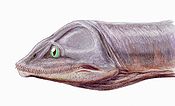


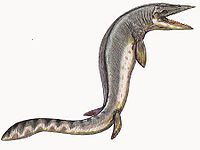
| Name | Period | Diet | |
|---|---|---|---|
| Ichthyosaur Ichthyosaur Ichthyosaurs were giant marine reptiles that resembled fish and dolphins... |
Triassic Triassic The Triassic is a geologic period and system that extends from about 250 to 200 Mya . As the first period of the Mesozoic Era, the Triassic follows the Permian and is followed by the Jurassic. Both the start and end of the Triassic are marked by major extinction events... |
Carnivore | Possibly an early Platypterygius Platypterygius Platypterygius was an ichthyosaur of the family Ophthalmosauridae. It is most closely related to the genera Caypullisaurus and Brachypterygius.-Discovery and species:... |
| Kaiwhekea Kaiwhekea Kaiwhekea is an extinct genus of plesiosaur from the Late Cretaceous of what is now New Zealand. The type species, Kaiwhekea katiki, was first described by Arthur Cruickshank and Ewan Fordyce in 2002. Kaiwhekea was approximately 7 meters long and lived around 69-70 million years ago... |
Cretaceous Cretaceous The Cretaceous , derived from the Latin "creta" , usually abbreviated K for its German translation Kreide , is a geologic period and system from circa to million years ago. In the geologic timescale, the Cretaceous follows the Jurassic period and is followed by the Paleogene period of the... |
Carnivore | |
| Liodon Liodon Liodon is a genus of mosasaur from the Late Cretaceous. Remains assigned to this genus have been found in Africa, Asia, Europe, America and South America, and New Zealand. It was first named by Richard Owen as Leiodon, but that name was already in use for a fish, necessitating the name... |
Cretaceous Cretaceous The Cretaceous , derived from the Latin "creta" , usually abbreviated K for its German translation Kreide , is a geologic period and system from circa to million years ago. In the geologic timescale, the Cretaceous follows the Jurassic period and is followed by the Paleogene period of the... |
Carnivore | The maximum length of NZ species is 30 ft. |
| Mauisaurus Mauisaurus Mauisaurus is a genus of plesiosaur that lived during the Late Cretaceous period around 80 to 69 million years ago in what is now New Zealand. It was the largest plesiosaur, and perhaps the largest marine reptile in New Zealand waters at the time. Mauisaurus haasti is the only known species of the... |
Cretaceous Cretaceous The Cretaceous , derived from the Latin "creta" , usually abbreviated K for its German translation Kreide , is a geologic period and system from circa to million years ago. In the geologic timescale, the Cretaceous follows the Jurassic period and is followed by the Paleogene period of the... |
Carnivore | Largest plesiosaur in New Zealand. |
| Moanasaurus Moanasaurus Moanasaurus was a genus of mosasaur from the Late Cretaceous period. Its fossil remains have been discovered in the North Island of New Zealand. Moanasaurus was a very large mosasaurine known originally from a disarticulated skull, vertebrae, ribs and paddle bones... |
Cretaceous Cretaceous The Cretaceous , derived from the Latin "creta" , usually abbreviated K for its German translation Kreide , is a geologic period and system from circa to million years ago. In the geologic timescale, the Cretaceous follows the Jurassic period and is followed by the Paleogene period of the... |
Carnivore | Largest mosasaur in New Zealand. |
| Mosasaurus Mosasaurus Mosasaurus is a genus of mosasaur, carnivorous, aquatic lizards, somewhat resembling flippered crocodiles, with elongated heavy jaws. The genus existed during the Maastrichtian age of the Cretaceous period , around 70-65 millions years ago in the area of modern Western Europe and North America... flemingi |
Cretaceous Cretaceous The Cretaceous , derived from the Latin "creta" , usually abbreviated K for its German translation Kreide , is a geologic period and system from circa to million years ago. In the geologic timescale, the Cretaceous follows the Jurassic period and is followed by the Paleogene period of the... |
Carnivore | Junior synonym of Moanasaurus Moanasaurus Moanasaurus was a genus of mosasaur from the Late Cretaceous period. Its fossil remains have been discovered in the North Island of New Zealand. Moanasaurus was a very large mosasaurine known originally from a disarticulated skull, vertebrae, ribs and paddle bones... . |
| Nothosaur Nothosaur Nothosaurs were Triassic marine sauropterygian reptiles that may have lived like seals of today, catching food in water but coming ashore on rocks and beaches. They averaged about in length, with a long body and tail. The feet were paddle-like, and are known to have been webbed in life, to help... |
Triassic Triassic The Triassic is a geologic period and system that extends from about 250 to 200 Mya . As the first period of the Mesozoic Era, the Triassic follows the Permian and is followed by the Jurassic. Both the start and end of the Triassic are marked by major extinction events... |
Carnivore | |
| Pontosaurus Pontosaurus Pontosaurus is a now extinct genus of pythonomorph from the Late Cretaceous period. It was originally named Hydrosaurus, but that name was preoccupied by an agamid lizard, so it was renamed.... |
Cretaceous Cretaceous The Cretaceous , derived from the Latin "creta" , usually abbreviated K for its German translation Kreide , is a geologic period and system from circa to million years ago. In the geologic timescale, the Cretaceous follows the Jurassic period and is followed by the Paleogene period of the... |
Carnivore | |
| Prognathodon Prognathodon Prognathodon is an extinct genus of marine reptile belonging to the mosasaur family. It had protective bony rings surrounding its eye sockets, indicating it lived in deep water. its fossil remains have been found in the U.S.A , Canada , Belgium, New Zealand, Morocco and The Netherlands... |
Cretaceous Cretaceous The Cretaceous , derived from the Latin "creta" , usually abbreviated K for its German translation Kreide , is a geologic period and system from circa to million years ago. In the geologic timescale, the Cretaceous follows the Jurassic period and is followed by the Paleogene period of the... |
Carnivore | |
| Pterosaur Pterosaur Pterosaurs were flying reptiles of the clade or order Pterosauria. They existed from the late Triassic to the end of the Cretaceous Period . Pterosaurs are the earliest vertebrates known to have evolved powered flight... |
Early Cretaceous Early Cretaceous The Early Cretaceous or the Lower Cretaceous , is the earlier or lower of the two major divisions of the Cretaceous... |
Carnivore | Possibly Mythunga Mythunga Mythunga is a genus of pterodactyloid pterosaur from the late Early Cretaceous of Australia. It is known from a partial skull found in marine rocks of the Albian-age Toolebuc Formation near Hughenden, Queensland. Only the snout and part of the jaws are known... . |
| Rikkisaurus | Cretaceous Cretaceous The Cretaceous , derived from the Latin "creta" , usually abbreviated K for its German translation Kreide , is a geologic period and system from circa to million years ago. In the geologic timescale, the Cretaceous follows the Jurassic period and is followed by the Paleogene period of the... |
Carnivore | Junior Synonym of Moanasaurus Moanasaurus Moanasaurus was a genus of mosasaur from the Late Cretaceous period. Its fossil remains have been discovered in the North Island of New Zealand. Moanasaurus was a very large mosasaurine known originally from a disarticulated skull, vertebrae, ribs and paddle bones... . |
| Saurichthys Saurichthys Saurichthys is an extinct genus of ray-finned fish from the Triassic period. Fossils have been found worldwide.Saurichthys was an elongated, streamlined, fish about long, and looked similar to the modern pike. Its dorsal and anal fins were placed opposite each other wll back on the body, and the... |
Triassic Triassic The Triassic is a geologic period and system that extends from about 250 to 200 Mya . As the first period of the Mesozoic Era, the Triassic follows the Permian and is followed by the Jurassic. Both the start and end of the Triassic are marked by major extinction events... |
Carnivore | Prehistoric barracuda Barracuda The barracuda is a ray-finned fish known for its large size and fearsome appearance. Its body is long, fairly compressed, and covered with small, smooth scales. Some species could reach up to 1.8m in length and 30 cm in width... . |
| Sphenodon Tuatara The tuatara is a reptile endemic to New Zealand which, though it resembles most lizards, is actually part of a distinct lineage, order Sphenodontia. The two species of tuatara are the only surviving members of its order, which flourished around 200 million years ago. Their most recent common... |
Mesozoic Mesozoic The Mesozoic era is an interval of geological time from about 250 million years ago to about 65 million years ago. It is often referred to as the age of reptiles because reptiles, namely dinosaurs, were the dominant terrestrial and marine vertebrates of the time... -Holocene Holocene The Holocene is a geological epoch which began at the end of the Pleistocene and continues to the present. The Holocene is part of the Quaternary period. Its name comes from the Greek words and , meaning "entirely recent"... |
Carnivore | Extant. |
| Taniwhasaurus Taniwhasaurus Taniwhasaurus is an extinct genus of mosasaur, a carnivorous, marine reptile which inhabited New Zealand, Japan and Antarctica. The genus was a close relative of the genera Tylosaurus and Hainosaurus.-Species:-T... |
Cretaceous Cretaceous The Cretaceous , derived from the Latin "creta" , usually abbreviated K for its German translation Kreide , is a geologic period and system from circa to million years ago. In the geologic timescale, the Cretaceous follows the Jurassic period and is followed by the Paleogene period of the... |
Carnivore | |
| Tuarangisaurus Tuarangisaurus Tuarangisaurus is an extinct genus of elasmosaurid known from New Zealand. Tuarangisaurus is known from the holotype NZGS CD425, a nearly complete skull and mandible and from NZGS CD426, nine anterior-most cervical vertebrae... |
Cretaceous Cretaceous The Cretaceous , derived from the Latin "creta" , usually abbreviated K for its German translation Kreide , is a geologic period and system from circa to million years ago. In the geologic timescale, the Cretaceous follows the Jurassic period and is followed by the Paleogene period of the... |
Carnivore | |
| Tylosaurus Tylosaurus Tylosaurus was a mosasaur, a large, predatory marine lizard closely related to modern monitor lizards and to snakes.-Paleobiology:... haumuriensis |
Cretaceous Cretaceous The Cretaceous , derived from the Latin "creta" , usually abbreviated K for its German translation Kreide , is a geologic period and system from circa to million years ago. In the geologic timescale, the Cretaceous follows the Jurassic period and is followed by the Paleogene period of the... |
Carnivore | Synonym of Taniwhasaurus Taniwhasaurus Taniwhasaurus is an extinct genus of mosasaur, a carnivorous, marine reptile which inhabited New Zealand, Japan and Antarctica. The genus was a close relative of the genera Tylosaurus and Hainosaurus.-Species:-T... . |
Dinosaurs that live in the Ross Dependency
Ross Dependency
The Ross Dependency is a region of Antarctica defined by a sector originating at the South Pole, passing along longitudes 160° east to 150° west, and terminating at latitude 60° south...
, a part of Antarctica within the Realm of New Zealand
Realm of New Zealand
The Realm of New Zealand is the entire area in which the Queen in right of New Zealand is head of state. The Realm comprises New Zealand, the Cook Islands, Niue, Tokelau and the Ross Dependency in Antarctica, and is defined by a 1983 Letters Patent constituting the office of Governor-General of New...
include the 20 foot long carnosaur Cryolophosaurus
Cryolophosaurus
Cryolophosaurus was a large theropod dinosaur, with a crest on its head that looked like a Spanish comb. Due to the resemblance of this feature to Elvis Presley's pompadour haircut from the 1950s, this dinosaur was at one point informally known as "Elvisaurus".Cryolophosaurus was excavated from...
, sometimes nicknamed Elvisaurus because of the shape of its head crest. It is important to remember that the Ross Dependency
Ross Dependency
The Ross Dependency is a region of Antarctica defined by a sector originating at the South Pole, passing along longitudes 160° east to 150° west, and terminating at latitude 60° south...
, unlike the Chatham Islands
Chatham Islands
The Chatham Islands are an archipelago and New Zealand territory in the Pacific Ocean consisting of about ten islands within a radius, the largest of which are Chatham Island and Pitt Island. Their name in the indigenous language, Moriori, means Misty Sun...
, is not actually part of New Zealand
New Zealand
New Zealand is an island country in the south-western Pacific Ocean comprising two main landmasses and numerous smaller islands. The country is situated some east of Australia across the Tasman Sea, and roughly south of the Pacific island nations of New Caledonia, Fiji, and Tonga...
, and this is why it is excluded from the list above until sufficient evidence shows that it entered what was the sector of Gondwana
Gondwana
In paleogeography, Gondwana , originally Gondwanaland, was the southernmost of two supercontinents that later became parts of the Pangaea supercontinent. It existed from approximately 510 to 180 million years ago . Gondwana is believed to have sutured between ca. 570 and 510 Mya,...
that is now New Zealand
New Zealand
New Zealand is an island country in the south-western Pacific Ocean comprising two main landmasses and numerous smaller islands. The country is situated some east of Australia across the Tasman Sea, and roughly south of the Pacific island nations of New Caledonia, Fiji, and Tonga...
. For more dinosaurs of Antarctica, click here.
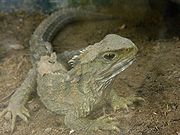
Tuatara
TuataraTuatara
The tuatara is a reptile endemic to New Zealand which, though it resembles most lizards, is actually part of a distinct lineage, order Sphenodontia. The two species of tuatara are the only surviving members of its order, which flourished around 200 million years ago. Their most recent common...
, the common (Māori) name for three species of reptile in the Sphenodon genus, is referred to as a "living dinosaur". From a taxonomic viewpoint this is incorrect. Sphenodon species evolved before dinosaurs emerged and were displaced by them.

